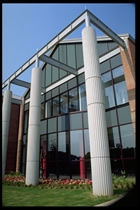Anodizing Definitions & Methods
Anodizing, What Is It?
Anodizing successfully combines science with nature to create one of the world’s best metal finishes.
It is an electrochemical process that thickens and toughens the naturally occurring protective oxide. The resulting finish, depending on the process, is the second hardest substance known to man, second only to the diamond. The anodic coating is part of the metal, but has a porous structure which allows secondary infusions, (i.e. organic and inorganic coloring, lubricity aids, etc.)
Anodizing Definitions and Methods
 While the chemical anodizing process remains the same for all applications, the mechanical methods vary according to the two physical types and shapes of metals used:
While the chemical anodizing process remains the same for all applications, the mechanical methods vary according to the two physical types and shapes of metals used:
Batch Anodizing
Involves racking parts and immersing them in a series of treatment tanks. Extrusions, sheets or bent metal parts, castings, cookware, cosmetic cases, flashlight bodies, and machined aluminum parts are just a few of the items that are batch anodized.
Continuous Coil Anodizing
Involves continuous unwinding of pre-rolled coils through a series of anodizing, etching and cleaning tanks, and then rewinding for shipment and fabrication. This method is used for high volume sheet, foil and less severely formed products such as lighting fixtures, reflectors, louvers, spacer bars for insulated glass, and continuous roofing systems.
Appearance options and quality are improved through the use of dyes and special pretreatment procedures. This makes the aluminum look like pewter, stainless steel, copper, brushed bronze or polished brass and can also be colored with brilliant blues, greens, reds, and many varieties of metallic gold and silver.
The unique dielectric properties of an anodized finish offer many opportunities for electrical applications.
The surface of the aluminum itself is toughened and hardened to a degree unmatched by any other process or material. The coating is 30 percent thicker than the metal it replaces, since the volume of oxide produced is greater than that of the metal replaced.
The resulting anodic coating is porous, allowing relatively easy coloring and sealing.
Hard Anodizing is a term used to describe the production of anodic coatings with film hardness or abrasion as their primary characteristic. They are usually thick by normal anodizing standards (greater than 25 microns) and they are produced using special anodizing conditions (very low temperature, high current density, special electrolytes). They find application in the engineering industry for components which require a very wear resistant surface such as piston, cylinders and hydraulic gear. They are often left unsealed, but may be impregnated with materials such as waxes or silicone fluids to give particular surface properties.
Batch And Coil Anodizing
Batch and coil anodizing are accomplished in five carefully controlled, calibrated, quality-tested stages:
Cleaning
Alkaline and/or acid cleaners remove grease, and surface dirt.
Pre-Treatment
- Etching
An appealing matte surface finish is created with hot solutions of sodium hydroxide to remove minor surface imperfections. A thin layer of aluminum is removed to create a matte or dull finish. - Brightening
A near mirror finish is created with a concentrated mixture of phosphoric and nitric acids which chemically smooths the aluminum’s surface.
Anodizing
The anodic film is built and combined with the metal by passing an electrical current through an acid electrolyte bath in which the aluminum is immersed. The coating thickness and surface characteristics are tightly controlled to meet end product specifications.
 Coloring – Coloring is achieved in one of four ways:
Coloring – Coloring is achieved in one of four ways:
- Electrolytic Coloring (The two-step method) – After anodizing, the metal is immersed in a bath Anodizing Line containing an inorganic metal salt. Current is applied which deposits the metal salt in the base of the pores. The resulting color is dependent on the metal used and the processing conditions (the range of colors can be expanded by overdyeing the organic dyes). Electrolytic colors can be specified from any AAC member. Commonly used metals include tin, cobalt, nickel, and copper. This process offers color versatility and the most technically advanced coloring quality.
- Integral Coloring – This so-called one-step process combines anodizing and coloring to simultaneously form and color the oxide cell wall in bronze and black shades while more abrasive resistant than conventional anodizing. It is the most expensive process since it requires significantly more electrical power.
- Organic Dyeing – The organic dyeing process produces a wide variety of colors. These dyes offer vibrant colors with intensities that cannot be matched by any other paint system in the market. They can also provide excellent weather-fastness and light-fastness. Many structures built with these finishes have lasted more than 20 years. The color range can be broadened by over-dyeing the electrolytic colors with the organic dyes for a wider variety of colors and shades. This method is relatively inexpensive and involves the least amount of initial capital of any other coloring process.
- Interference Coloring – An additional coloring procedure, recently in production, involves modification of the pore structure produced in sulfuric acid. Pore enlargement occurs at the base of the pore. Metal deposition at this location produces light-fast colors ranging from blue, green and yellow to red. The colors are caused by optical-interference effects, rather than by light scattering as with the basic electrolytic coloring process. Further development will produce a greater variety of colors.
Here is detailed information comparing two of the most common coloring processes used: (note – these two types of processes will not produce identical colors; both can be overdyed. Source: Aluminum Anodizers Council Technical Bulletin #1-94, issued January, 1994.) See below.
Sealing
This process closes the pores in the anodic film, giving a surface resistant to staining, abrasion, crazing, and color degradation.
Quality Control
Through the entire anodizing process, AAC members like SAF monitor the process and quality of the product. The application of electrical power and color is preprogrammed and verified on all batches and coils.
This quality control ensures uniformity to end product specifications for film thickness, density, abrasion resistance, corrosion resistance, color uniformity, fade resistance, reflectivity, image clarity, insulative properties, adhesion and sealing.
In many cases anodizers use Statistical Process Control (SPC) methods to meet rigorous quality assurance standards.
